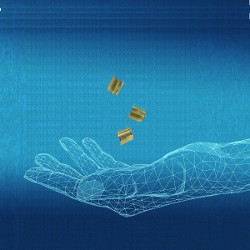
Semiconductors have radically changed the world. Today, they serve as the brains for computers, smartphones, home electronics, and a growing array of connected devices. Yet, there's a big problem: it is difficult (often impossible) to use silicon in harsh environments, where it may be exposed to water, dirt, and temperature extremes.
In addition, conventional silicon fabrication processes are expensive, and they require substantial resources. Explains John Biggs, Distinguished Engineer at U.K.-based semiconductor and software design firm Arm, "Silicon has undergone an unbelievable transformation over the last few decades. However, silicon-based electronics can face challenges in certain applications and situations. There's a need for more versatile and inexpensive microchips."
The answer may lie in plastic semiconductors.
After more than two decades of research into flexible electronics, the concept is finally taking hold. Last year, the idea of using plastic chips took a leap forward when Arm and Cambridge, U.K.-based PragmatIC Semiconductor announced they had jointly developed a plastic chip that could eventually be used in a wide variety of situations.
"What's exciting about PragmatIC's technology is that it creates a way to put electronics in and on products that wouldn't normally be considered electronic," says Catherine Ramsdale, senior vice president of Technology at PragmatIC Semiconductor. Adds Biggs: "Very cheap and flexible processors may lead to the Internet of Everything."
Beyond Silicon
The idea of producing flexible semiconductors dates back more than two decades. Bell Laboratories began exploring the concept in the late 1990s, and various designs and prototypes have emerged using paper, plastic, or metal foil substrates. In 2000, for example, researchers at Cambridge University developed an inexpensive microchip technology using plastic. At that time, the goal was to build flexible displays and embed chips in clothing.
Researchers have continued to explore the space, which could revolutionize fields such as medicine and biomedicine (the application of biological and physiological principles to clinical practice), industrial and environmental monitoring, and smart cities. Plastic chips could be used as smart labels on shipping containers and food packages to monitor temperatures and spoilage, in chemical tanks to gauge temperatures and the buildup of gasses, on perfume bottles to prevent counterfeiting, and on or in the human body to dispense medicine or monitor disease.
"There are an enormous number of potential applications for flexible electronics, particularly in medicine and biomedicine," says John Rogers, professor of Material Science at Northwestern University. "The use of plastic and organic materials introduces possibilities that are outside the scope of conventional semiconductors."
The PragmatIC chip relies on a 32-bit Cortex-M0 CPU processor called PlasticArm, which can be produced for pennies per chip. All the circuits are fabricated directly onto a plastic substrate using standard industry processes. Although the current design is equipped only with read-only memory—which means it can only execute hard-wired code—future versions of the technology could incorporate programmable and flexible memory, Ramsdale says.
This makes PlasticArm the most advanced flexible microchip that has been developed to date. The current design—the first non-silicon Arm processor designed with thin film transistors on a flexible substrate—incorporates 56,340 components within 60 sq. mm. It supports 456 bytes of ROM and 128 bytes of RAM, a 12x improvement over other flexible chips. Nevertheless, Biggs says the 0.8-micron technology trails silicon by three or four decades.
"PragmatIC's technology is not intended to replace silicon, it's designed to complement it," Ramsdale explains. "There are many situations where you don't need high processing power, you only want to do some basic computation. This scales the cost from a couple of dollars to a couple of cents per chip. It makes it possible to greatly expand the use of electronics and computing."
Flexing Logic
Arm's Biggs says the development of this plastic chip is not the goal. Researchers and engineers continue to explore materials and work on both scaling up onboard processing and improving manufacturing yields. This might include researching hybrid techniques that combine plastics and other flexible substrates with more conventional silicon-based processors. It could involve grinding down silicon or fabricating the chip in different ways.
Hybrid chips represent a powerful framework, Rogers says. "You can develop high-performance classes of electronic materials to build flexible devices for specific purposes." Adds Biggs, "It's possible to engineer extremely flexible but powerful smart sensors that can handle processing on the edge. They can triage data and send only useful data to the cloud."
For now, the breakthrough represents an important step in broadening the Internet of Things and making compute power more ubiquitous and pervasive. Over the next few years, It could come to milk cartons, bandages, and even whiskey bottles.
"This technology can add intelligence to a wide array of tasks—from monitoring foods to analyzing wounds," Ramsdale says. "It adds a layer of intelligence that RFID and other wireless technologies cannot deliver."
Samuel Greengard is an author and journalist based in West Linn, OR, USA.



Join the Discussion (0)
Become a Member or Sign In to Post a Comment